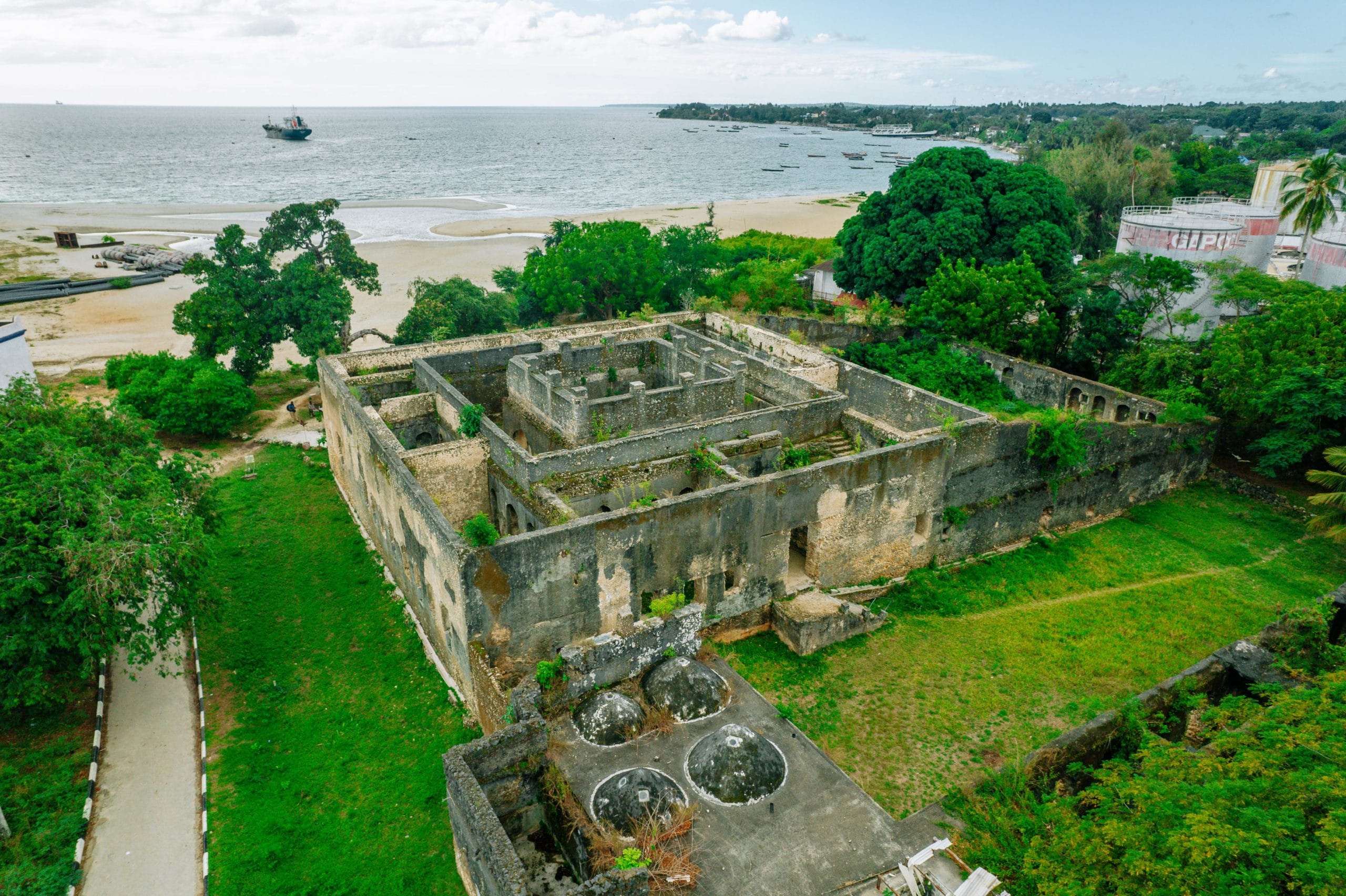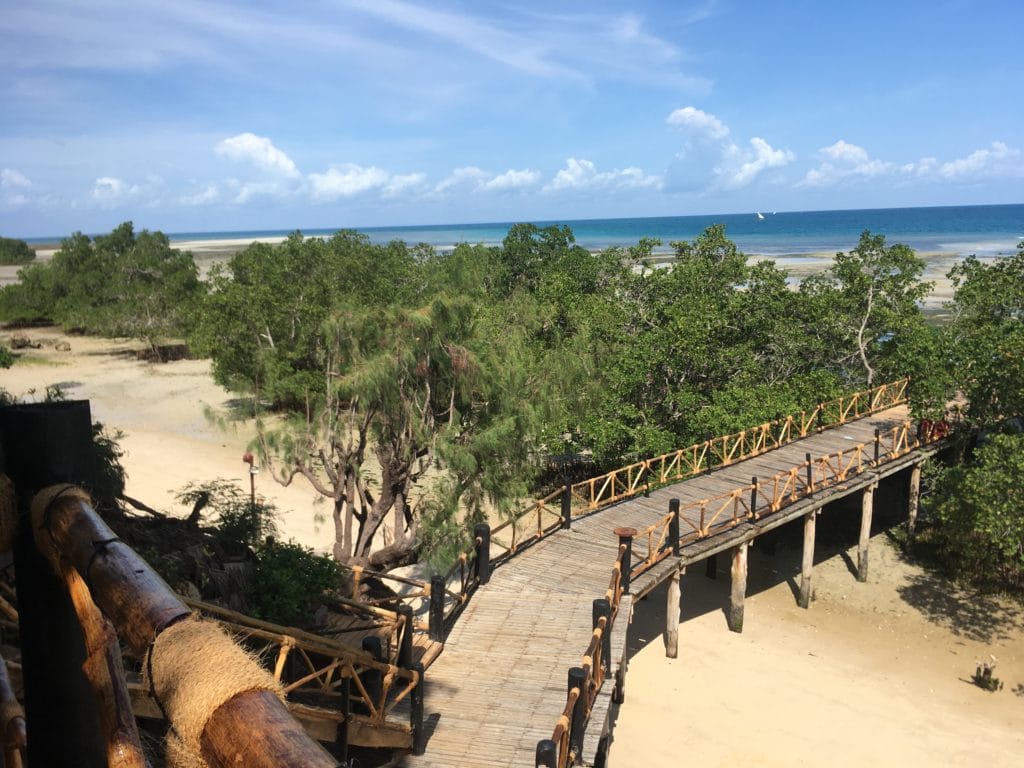
Historic Mtoni and Mbweni ruins at cross roads
Zanzibar has a rich cultural heritage – an enormous potential for tourism. But so far, the island hasn’t shown little real interest in conservation. Two beautiful and significant just-out-of-town ruins are currently awaiting better times.
Saleh Mohammed is sitting behind a shaky wooden table in the shade of a lonesome Mango tree, a few flyers about „candle light dinners“ and „living history tours“ in front of him. But there have been no dinners for years. No tourists either. We ask Saleh, 31, when the last holidaymaker visited Mtoni ruins, the precious remains of the oldest and grandest sultan palace in Zanzibar. „No tourists today, last week and last month also none“, the jobless tour guide replied dryly. This sounds rather strange, since the palace ruins stand right next to the imposing Hotel Verde, about five kilometres north of Zanzibar City. But the non-alcoholic 5-star resort seems to have other priorities like an aqua fun park. Built in the ocean against environmentalists’ warnings the plastic attraction did not survive currents and winds; a replacement in the parking lot is also meanwhile defunct.
Mbweni – a school
for freed slave girls
A different picture presents itself to us on the southern outskirts of Zanzibar city where the Mbweni ruins, delicate remains of a former convent and 19th century school for freed girl slaves, are presently being integrated into a new hotel, “Jungle Paradise”. After several ownership changes and years of neglect, the historic floors are now swept and clean again; bougainvillea entwines on old walls. “With 670 plant and tree species, among them 200 different kinds of palm trees, we plan to open a botanical garden soon”, explains new hotel owner Christian Rockenbauer, who took over the premises recently.
The 46-year-old German immediately restored the old 120-metre-pier going into the Indian Ocean, opened a new sunset bar and generally overhauled the tired-looking former Protea premises, one of the few west coast hotels with a proper beach.
After-work events on Fridays and a brunch club now attract a young crowd. “The Mbweni ruins are one of our main attractions,” Chris Rock explains to me, “we will definitely incorporate them; the old chapel is ideal for weddings.”
How many orphaned girls may have dreamt of their own weddings here in the former Victorian St. Mary’s School? Freed from captured slave dhows between 1870 and1900, they were trained as teachers, in basketry, stitching and cooking. In 1906 the school, incorporating an old Arab house, became a convent. The two-storey complex later deteriorated into a ruin but the chapel, whilst lacking a roof, is intact and has even been used for yoga classes some time ago.



Why is Mtoni palace
forgotten?
The Mtoni Palace ruins on the other hand, two kilometres north of Maruhubi, look deserted although the remains, overgrown with grass, still look impressive: several private hamams, an aqueduct which once brought chem-chem mountainwater to “Beit il Mtoni” and a regal inner courtyard. When THE FUMBA TIMES photographer Keegan Cheick let his drone fly over the structures, the old palace layout became clearly distinguishable. „We used to take care of the palace, even provided concepts for its future use which were all rejected by the government. Then we returned the monument to the government in 2018“, manager Nasheeb Uddin of Bakhresa-owned Hotel Verde explains.
The weathered grey stone labyrinth right on the shore of the Indian Ocean, the oldest palace in Zanzibar, was home to Sultan Seyyid Said (1806-1856), his only legitimate wife, 75 concubines and 36 children. In its heyday, around a thousand people, most of them slaves, lived here, among them the sultan’s youngest daughter Princess Salme who later became famous when she escaped to Germany with a German merchant. Explorer Richard Burton described the royal home as “half castle, half chateau” with “a quaint Gothic look”. “Most of the day”, Salme alias Emily Ruete wrote in her memoirs from 1886, “we were playing around with peacocks, or resting in one of the many steam rooms in the large bath tract.” After the sultan’s death the palace lost its importance.
Tourism minister Lela Mussa:
“Will make Mtoni a museum”
I am meeting the man who knows many historical details about the site and successfully ran it some time as a cultural event spot. Tonino, as everybody calls him, is Italian and a long-time Zanzibar entrepreneur. “Concept? Nobody had a concept!” he indignantly exclaims, when I report my findings at Hotel Verde to him. “All they had planned was to put aluminium windows in the ancient coral palace walls.” That, luckily, didn’t happen - but nothing else either. When contacted by THE FUMBA TIMES, Zanzibar’s new Minister of Tourism and Cultural Heritage, Lela Muhamed Mussa, however now announced: “We are going to revive Mtoni and turn it into a museum”. The restoration would be “part of a bigger cooperation with Oman to restore all major monuments”, the minister said.
Historic Stone Town, UNESCO-protected since 2000, has seen many attempts at restoration efforts, but UNESCO strongly criticised Zanzibar for “mismanagement of cultural heritage” in 2016. The premier monument in town, the House of Wonder built in 1883, collapsed last Christmas Day.
Nostalgic tours
in conkey carts
Mtoni was not always forgotten. Between 2000 and 2015, the ruins were full of life, attached to the Mtoni Marine Hotel, the popular forerunner of Hotel Verde. “We had hundreds of Taarab concerts there, fashion shows and lectures”, recalls Antonio “Tonino” Garau, 56: “In Italy culture drives tourism, we did the same in Zanzibar then.” Stefanie Schoetz, the Dutch owner of traditional Mrembo Spa, drove tourists around in a thatched cart pulled by a donkey during nostalgic tours in the tracks of Princess Salme. She even got the Netherlands involved in drafting an elaborate 28-page architectural “Sketch for a future life” in Mtoni. But somehow it all died off. “You need an investor with a cultural awareness for such activities”, Tonino sums up the ensuing story of neglect.
”It is vital for Zanzibar to preserve a tangible reminder of their past”, historians support that view in a picture book, he co-authored, simply called “Mtoni” (2010). It can only be hoped that politicians and investors of today wake-up to that message before nothing of the heritage is left.